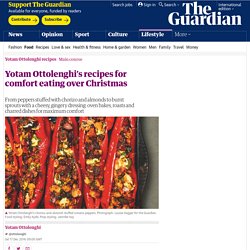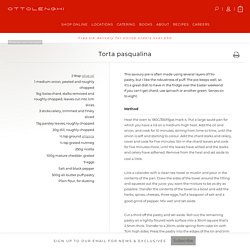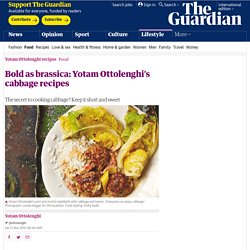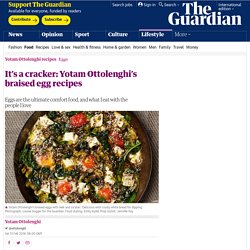

Yotam Ottolenghi’s recipes for comfort eating over Christmas. I usually do three recipes for this column, but I got a bit overexcited in the run-up to Christmas, so this week I’ve squeezed in four, all of them baked, charred or roasted for extra comfort.

(And anyway, what kind of food writer would I be if I didn’t provide a recipe for sprouts at this time of year?) So, happy planning, cooking and feasting. Chorizo-and-almond-stuffed romano peppers Serve as a standalone meal, perhaps with a crisp green salad, or as an side for roast chicken. The stuffing mix also works in a chicken and even baked on its own. Heat the oven to 200C/390F/gas mark 6. Put the sourdough in a food processor and blitz for a minute, to turn it into rough crumbs (the largest pieces should be about 1cm). Use a small knife to cut a long, narrow V down the centre of each pepper, 2cm wide at the stalk and narrowing down towards the tip. Potato and mushroom pots Heat the oven to 220C/425F/gas mark 7. Turn down the oven to 200C/390F/gas mark 6. Start with the dressing.
Yotam Ottolenghi’s tray bake recipes. I’ve been making lots of tray bakes recently.

I am not sure I like the term – 1970s convenience food springs to mind – but I love what it stands for: the idea that, after doing the prep, you can sit down with a cuppa or a glass of wine and relax for an hour or two while your meal more or less cooks itself. And, unlike a stew, which offers the cook a similar break, a bake retains much of the freshness and integrity of its components, particularly vegetables.
Pasta and butternut squash cake (pictured above) This ‘cake’ was a revelation to me: who would have thought you could cook pasta for two hours and end up with something fresh, super-comforting and full of texture? Yotam Ottolenghi’s summer courgette recipes. Looking back on what I’ve written about courgettes in the past, I see that I’ve been too apologetic.

I’ve always loved these baby marrows, but for some reason have felt the need to justify them. For example, my adoration of stuffed courgettes, which would definitely feature in my final meal, seems always to come with a disclaimer that they’re no thing of beauty once that vibrant green skin turns a dull grey after two hours in the pan. Likewise, I’ve somehow invariably explained away courgettes’ unerring ability to showcase a sharp lemon dressing or sorrel and pistachio pesto by saying that this is because courgette has an essentially bland and watery flavour in the first place.
Many chefs I’ve worked with have held such negative opinions about these little moisture-packed cucurbits that my reaction has become reflex. Torta pasqualina I Ottolenghi recipes. This savoury pie is often made using several layers of filo pastry, but I like the robustness of puff.

The pie keeps well, so it's a great dish to have in the fridge over the Easter weekend. If you can't get chard, use spinach or another green. Serves six to eight. Method Heat the oven to 180C/350F/gas mark 4. Line a colander with a clean tea towel or muslin and pour in the contents of the pan. No trick, just treats: Yotam Ottolenghi’s pumpkin and squash recipes. The more familiar we become with images and stories from Syria that shock, the more essential it is to emphasise the humanity we all share, and how this is often made manifest through food.

That’s why I’ve given my support to the book Soup For Syria, as I wrote last week. Every conflict has a food story to tell, and in Food Stories From Syria, a recent Food Programme on Radio 4, Dan Saladino unveiled a few of those stories, told by asylum seekers, aid workers and food writers. Many of the stories we hear from the region are about a dire lack; but they are also connected by a sense of the pride that people have in relation to the food of their home country, as well as the humility and hospitality that goes into making and sharing it. Food writer Anissa Helou told Saladino about the shacks in Lebanon into which she has been invited to eat fattoush, a staple Syrian salad made with huge amounts of fresh herbs and toasted bread. Spiced minced lamb with spaghetti squash. Yotam Ottolenghi’s recipes for cooking with capers. Capers may be small, but their impact is big.

But only after those little olive-green flowerbuds have been pickled in brine or packed in salt. The smaller the caper, the better they are considered to be: nonpareil capers (named after the French for having no equal), are the smallest, and have to be less than 7mm to qualify for that name. As the size of the caper increases, its value diminishes, ranging from surfines (7mm) through to capucines (8-9mm), the widely-available capotes (9-11mm) and fines (11-13mm).
Those differences in size may seem minuscule, but the buds of the Capparis spinosa develop so fast that the bush has to be picked more or less daily. I love to sizzle them in hot oil and watch as the buds magically open like flowers. Know your leeks: Yotam Ottolenghi’s leek recipes. It’s that time again when we hear ourselves ask, “How did the year fly by so fast?”

Then, realising we haven’t seen nearly enough of our nearest and dearest, we make hasty plans to meet up before the Christmas deadline. Well, I feel much the same about leeks. Looking back on my year in the kitchen, I note that I’ve spent hardly any time with this member of the onion family. As is the case with longstanding friends, it’s easy to take leeks for granted: they always seem happy to play the supporting role – providing the savoury, almost meaty background note to so many soups, stews and gratins – rather than hogging the centre stage.
It’s the prized white base of the leek that you really want to put under the spotlight. In time-honoured mid-December fashion, I’ve been trying to make up for my neglect by cramming in as much time with leeks as I can in the last week or so, and they’ve been as comforting and familiar as any friend we haven’t seen enough of. Hot stuff: Yotam Ottolenghi’s harissa recipes. Malaysian sambal oelek, American Tabasco, Thai sriracha, Korean gochujang, Mexican luchito smoked chilli paste: there are enough savoury chilli sauces out there for even this fast-track-to-big-flavour avenue to feel a little crowded.

The Mexican luchito, for example, is sweet and garlicky, and made oily by the addition of dark agave nectar; gochujang is a savoury and relatively mild paste of chilli and fermented soybeans; and, with its sharp blend of chillies, vinegar and salt, a little goes a long way with Louisiana’s Tabasco sauce. My favourite of all the chilli sauces, however, is the potent North African harissa. I use it in all sorts: for marinading meat and fish, for mixing with sweet roast carrots, for swirling through a root vegetable or garlic soup, or just for serving with couscous or rice.
There’s a huge range of ready-made harissas, but homemade is even more delicious, and satisfying, too; it means you get to control its heat levels.
Bold as brassica: Yotam Ottolenghi’s cabbage recipes. The cabbage family is both large (there are more than a dozen relatives) and strong-flavoured.

Cabbage tissue contains two kinds of chemical that contribute to this: the flavour precursors (that green, grassy aroma uncooked cabbage has when it’s cut) and the enzymes, which react with those precursors when cooked. The longer cabbage cooks, the more it smells – and the more likely it is to send some people, children especially, running a mile. There are ways around this, though. The first is not to overcook it, obvious as that sounds. It also helps to blanch the leaves first, which stops enzyme activity and helps retain that fresh aroma.
It’s a cracker: Yotam Ottolenghi’s braised egg recipes. The connection between eggs and Valentine’s Day possibly makes more sense in my head than on the page: for me, there’s something about eggs as the essence of life, the start of it all, that inextricably links them to that first spark of romance.

Then there’s the way that eggs, like people, are transformed from something that lacks structure to something with a uniform bond: through whisking and heat; or compromise and teamwork. It turns out that eggs and Valentine’s Day have an even simpler connection than that. Eggs are the ultimate comfort food, and comfort food is what I like to eat at home, where I share it with the people I love. Rise and shine: Yotam Ottolenghi’s recipes for home-baked bread. In last week’s column, I said that bread baking is a pretty daunting proposition to many people, and that flatbreads were perhaps the ideal gateway to this wonderful art, because they’re often just cooked in a pan and need little or no fermentation.
Well, I’ve picked today’s recipes to show that risen loaves can also be pretty simple to make, and don’t require a whole lot of experience or skill, either. The process is very straightforward indeed: you combine flour, water, yeast and salt, then knead the mix (or not, as in the case of today’s first recipe) to develop the glutens, before letting time do its thing, so the yeast can produce carbon dioxide and fill the dough with gas cells. Finally, bake the dough to set the loaf’s structure and generate that gorgeous bread flavour. So, just four simple steps, but with so many possibilities and choices as to what you can add to the dough, how you shape it and how it gets baked. No-knead bread Challah Potato focaccia. A match made in heaven: Yotam Ottolenghi’s peach and raspberry recipes.
I’m about to start shooting for my next book, which is full of sweet things. About two-thirds of the way through writing it, I realised there was something lacking: colour. One of the challenges of photographing dishes such as tahini caramel shortbread, coffee and walnut financiers, and cappuccino cupcakes is that they’re all, essentially, various shades of brown and beige. Delicious, yes, but a bit 1970s furniture to look at on the page. So I rolled out the red carpet for berries, to brighten up proceedings, and raspberries in particular. Chard taskmaster: Yotam Ottolenghi’s recipes for swiss chard. Just about everyone seems to be on their summer break right now, so this week’s lead ingredient keeps the holiday theme going: swiss chard has leaves so large, they look a bit like the huge fan you’d want to waft about you in the midday sun, while its stalks are as white as some British legs abroad.
For those holidaying closer to home, chard is in its element. Purple reign: Yotam Ottolenghi’s aubergine recipes. I am feeling stupidly nostalgic this week, because it’s 10 years since I started writing my Weekend column, and next week will be my 500th in total. It began life as The New Vegetarian, and one ingredient that has been at the heart of so many of my favourite dishes, then and now, is the aubergine – in my book Plenty, my first collection of Guardian recipes, I even had one chapter called The Mighty Aubergine. Yotam Ottolenghi’s pepper recipes. Peppers are so ubiquitous and versatile that they can, perversely, be easy to overlook. Rather like onions and celery, they’re so much in the background that they rarely make it on to “favourite vegetable” lists in the way that, say, potatoes, carrots and peas do. (Apologies if you don’t carry such a list in your mind: I’m asked to name my favourite vegetable so often that I have started to think such lists are a totally normal way to fill up head space.)
Peppers do a lot of the heavy work in the kitchen. Yotam Ottolenghi’s walnut recipes. Walnuts are the second most popular nut in the world, after almonds. In my kitchen, however, they are second to none. The short season for young, fresh “wet” walnuts is upon us, and few things give me as much pleasure as cracking open the hard, dry shell of a newly-picked nut to reveal that moist, pale kernel inside. Yotam Ottolenghi’s winter soup recipes.
January can be a confusing time, but the general resolve is to eat less and move more. After a month of potatoes roasted in duck fat, wedges of stilton and brandy-soaked cake, we somehow convince ourselves that a diet of blitzed green things, sprouted seeds and not a drop of wine is what our body needs in the deep midwinter. Yotam Ottolenghi’s dumpling recipes. The brilliant Marina O’Loughlin, in a recent review of a dumpling restaurant, wrote that, “As the world inches closer to chaos, we focus hard on what we put into our faces.” In such times, it’s comfort and safety we seek, and dumplings (or “bite-sized bundles of deliciousness”, as Marina calls them) fit the bill perfectly. Yotam Ottolenghi’s meze recipes. I’ ve just got back from a trip to Georgia, the delicious details of which will no doubt feed my imagination, and these pages, at some point in the future.
That visit was immediately followed by a sad couple of days in Israel, where I attended a shiva, the Jewish week of family mourning after a death. Yotam Ottolenghi’s rhubarb recipes. Rhubarb is either forced or field-grown. The forced kind is the one everyone celebrates at the start of the year, when those slender, hot-pink stalks provide a welcome contrast to the greys of winter. It hands over the baton to field-grown rhubarb at the end of March/beginning of April, which is greener on account of being grown outdoors and so benefiting from photosynthesis, and has slightly stubbier stalks than forced. The two are pretty much interchangeable in cooking (though field-grown may need a touch more sugar).
Yotam Ottolenghi’s artichoke recipes. There are three ways to get to the heart of a globe artichoke. One is to do all the work yourself; to roll up your sleeves and get on with the task of chopping and trimming the outer leaves until you reach the heart and remove the choke. The second is to make a meal out of reaching the heart, picking away at those leaves and using them to scoop up all sorts of dips, until the heart reveals itself, prize-like, at the end. And the third way is to outsource the job entirely and start with jarred or frozen artichoke hearts. Yotam Ottolenghi’s peach recipes. I went to a party earlier this summer and took a tray of ripe peaches instead of a bottle of wine. I would never have dreamed of taking a tray of, say, avocados or a bunch of bananas. From pavlova to cheesecake: Yotam Ottolenghi’s 10 perfect dessert recipes.
My first job in a kitchen was whisking egg whites. It was the 1990s, and I was training by day and assisting the pastry chef in a fancy restaurant at night. I spent most of my time beating egg whites for vanilla soufflés; three months in, I was a soufflé expert. Yotam Ottolenghi’s lasagne recipes. The word “lasagne” is a bit like “sandwich” or “pie”: as a descriptor, it gets you only so far, because there are so many variables as to what you can put inside. Yotam Ottolenghi’s recipes for winter vegetables as standalone meals. Every weekend, the glossy supplements of all the newspapers (this one included) are filled with recipes, and for the past seven years food writer Ed Smith has taken it upon himself to catalogue and digest those recipes on his blog, Rocket & Squash.
In all that time, he noticed there was barely a handful of recipes for side dishes among them. “Which is madness,” he writes in his book On The Side (£20, Bloomsbury), which was inspired by this gap in the recipe-writing market: “A key part of every mealtime is being ignored.” Yotam Ottolenghi’s recipes for warming autumn soups. Yotam Ottolenghi’s recipes for fried party snacks for new year and beyond. Yotam Ottolenghi’s recipes for using up leftover bread. Cook smart: Yotam Ottolenghi’s recipe cheats. Yotam Ottolenghi’s asparagus recipes.
Yotam Ottolenghi’s lamb recipes. Yotam Ottolenghi’s summer recipes. From spicy beans to a fishy traybake: Yotam Ottolenghi’s 30-minute recipes. Ottolenghi Online store. Tarragon gondi I Ottolenghi recipes. Purple reign: Yotam Ottolenghi’s aubergine recipes. Yotam Ottolenghi’s recipes for Mother’s Day. Yotam Ottolenghi’s meze recipes. Yotam Ottolenghi’s pecorino recipes. Yotam Ottolenghi’s sweet potato recipes. Yotam Ottolenghi’s recipes for chorizo and ’nduja. Yotam Ottolenghi’s recipes for autumn bakes. Yotam Ottolenghi’s fennel recipes. Yotam Ottolenghi’s picnic recipes. Zing for your supper: Yotam Ottolenghi’s lime recipes. Chard taskmaster: Yotam Ottolenghi’s recipes for swiss chard. Easy Ottolenghi: vegetable recipes. Cook smart: Yotam Ottolenghi’s recipe cheats. Yotam Ottolenghi’s sage recipes. Yotam Ottolenghi’s beetroot recipes for autumn. Yotam Ottolenghi’s dumpling recipes.
Yotam Ottolenghi’s recipes for winter salads and slaws. Magic dust: Yotam Ottolenghi’s za’atar recipes. Yotam Ottolenghi’s recipes for a vegetarian Christmas. Udon noodles with miso and walnuts recipe. The new vegetarian: Yotam Ottolenghi prepares Quinoa salad with dried Iranian lime. On eating seasonally and roasted nectarines with cardamom honey. Ottolenghi. OTTOLENGHI QUINOA&CELERY ROOT. Yotam Ottolenghi’s sage recipes. OTTOLENGHI.